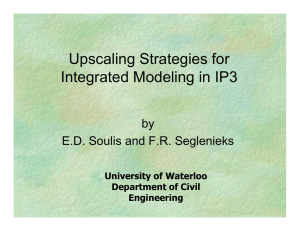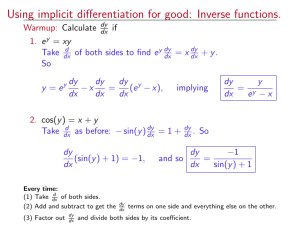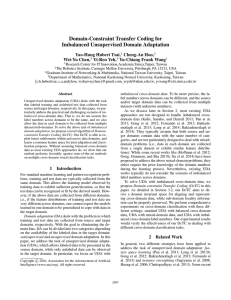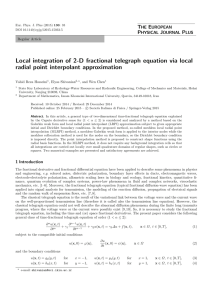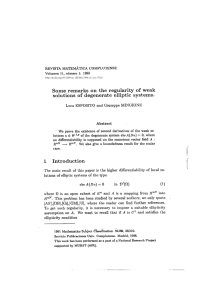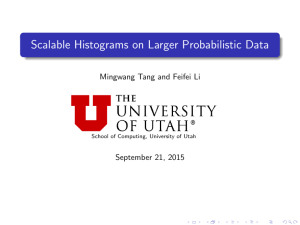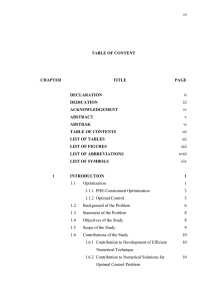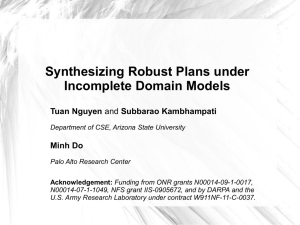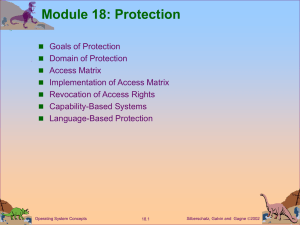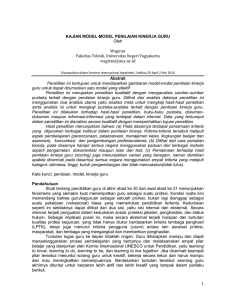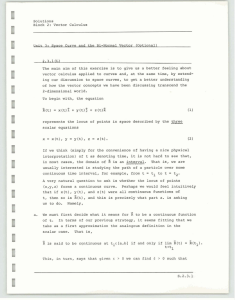Document 11901925
advertisement
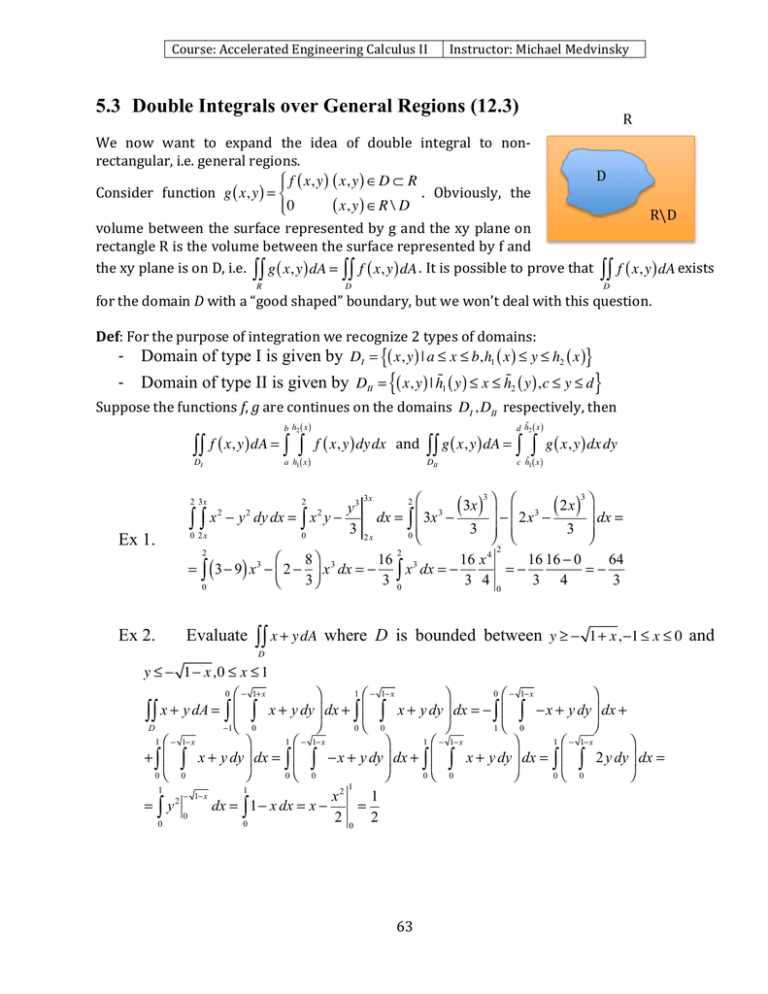
Course: Accelerated Engineering Calculus II Instructor: Michael Medvinsky 5.3 Double Integrals over General Regions (12.3)
R We now want to expand the idea of double integral to non-­‐
rectangular, i.e. general regions. D ⎪⎧ f ( x, y ) ( x, y ) ∈D ⊂ R
Consider function g ( x, y ) = ⎨
. Obviously, the ( x, y ) ∈R \ D
⎩⎪0
R\D volume between the surface represented by g and the xy plane on rectangle R is the volume between the surface represented by f and the xy plane is on D, i.e. ∫∫ g ( x, y ) dA = ∫∫ f ( x, y ) dA . It is possible to prove that ∫∫ f ( x, y ) dA exists R
D
D
for the domain D with a “good shaped” boundary, but we won’t deal with this question. Def: For the purpose of integration we recognize 2 types of domains: -­‐ Domain of type I is given by DI = {( x, y ) | a ≤ x ≤ b,h1 ( x ) ≤ y ≤ h2 ( x )}
-­‐ Domain of type II is given by D = ( x, y ) | h ( y ) ≤ x ≤ h ( y ),c ≤ y ≤ d
II
{
1
}
2
Suppose the functions f, g are continues on the domains DI , DII respectively, then b h2 ( x )
d h2 ( x )
∫∫ f ( x, y ) dA = ∫ ∫ f ( x, y ) dy dx and ∫∫ g ( x, y ) dA = ∫ ∫ g ( x, y ) dx dy a h1( x )
DI
c h1( x )
DII
2 3x
2
y3
∫0 2∫x x − y dy dx = ∫0 x y − 3
2
Ex 1.
2
2
3
3
⎛
3x ) ⎞ ⎛ 3 ( 2x ) ⎞
(
3
⎟ − ⎜ 2x −
⎟ dx =
dx = ∫ ⎜ 3x −
3
3
⎜
⎟
⎜
⎟⎠
0⎝
2x
⎠ ⎝
3x
2
2
2
2
⎛
8⎞
16
16 x 4
16 16 − 0
64
= ∫ ( 3− 9 ) x − ⎜ 2 − ⎟ x 3 dx = − ∫ x 3 dx = −
=−
=−
3⎠
3 0
3 4 0
3 4
3
⎝
0
3
Ex 2.
Evaluate
∫∫ x + y dA
where D is bounded between y ≥ − 1+ x,−1 ≤ x ≤ 0 and
D
y ≤ − 1− x,0 ≤ x ≤ 1
1 ⎛ − 1−x
0 ⎛ − 1−x
⎛ − 1+x
⎞
⎞
⎞
x
+
y
dA
=
x
+
y
dy
dx
+
x
+
y
dy
dx
=
−
−x
+
y
dy
⎜
⎟
⎜
⎟
⎜
⎟ dx +
∫∫D
∫ ∫
∫0 ⎝ ∫0
∫1 ⎝ ∫0
⎠
⎠
⎠
−1 ⎝ 0
1 ⎛ − 1−x
1
−
1−x
1
−
1−x
1
−
1−x
⎞
⎛
⎞
⎛
⎞
⎛
⎞
+ ∫ ⎜ ∫ x + y dy ⎟ dx = ∫ ⎜ ∫ −x + y dy ⎟ dx + ∫ ⎜ ∫ x + y dy ⎟ dx = ∫ ⎜ ∫ 2 y dy ⎟ dx = ⎠
⎠
⎠
⎠
0⎝ 0
0⎝ 0
0⎝ 0
0⎝ 0
0
1
=∫y
0
2
− 1−x
0
1
1
x2
1
dx = ∫ 1− x dx = x −
=
2 0 2
0
63 Course: Accelerated Engineering Calculus II Instructor: Michael Medvinsky Ex 3.
The
domain
in
previous exercise can also be described
D = {( x, y ) , y − 1 ≤ x ≤ 1− y ,−1 ≤ y ≤ 0} and the integral become more friendly
2
by
2
1− y 2
−1 2
−1
⎛
⎞
x
⎛ (1− y )
⎞ ⎛ ( y −1)
2
2
x
+
y
dA
=
x
+
y
dx
dy
=
+
xy
dy
=
⎜⎝ 2 + 1− y y ⎟⎠ − ⎜⎝ 2 + y − 1
⎟
∫∫D
∫0 ⎜⎝ ∫
∫
∫
2
⎠
0
0
y −1
y −1
−1
−1
2
4
⎛y
⎛ 1⎞ 1
y ⎞
= 2 ∫ y − y 3 dy = 2 ⎜ − ⎟ = ⎜ 1− ⎟ =
4⎠
⎝ 2⎠ 2
⎝ 2
−1 1− y 2
2
2
2
2
0
(
)
2
2
(
) y⎞⎟⎠ dy
0
Properties of Double Integrals: 1) ∫∫ f ( x, y ) + g ( x, y ) dA = ∫∫ f ( x, y ) dA + ∫∫ g ( x, y ) dA
D
D
D
2) ∫∫ cf ( x, y ) dA = c ∫∫ f ( x, y ) dA
D
D
3) f ( x, y ) ≥ g ( x, y ) ⇒ ∫∫ f ( x, y ) dA ≥ ∫∫ g ( x, y ) dA
D
D
4) D = D1 ∪ D2 ⇒ ∫∫ f ( x, y ) dA = ∫∫ f ( x, y ) dA + ∫∫ f ( x, y ) dA
D
D1
D2
5) ∫∫ f ( x, y ) dA = A ( D ) , i.e. the area of the domain D
D
6) m ≤ f ( x, y ) ≤ M ⇒ mA ( D ) ≤ ∫∫ f ( x, y ) dA ≤ MA ( D )
D
Ex 4.
Estimate
∫∫ sin xy dA ,
where D is the disc of radius 2: Since −1 ≤ sin xy ≤ 1
D
and A ( D ) = π r = 4π , therefore −4π ≤ ∫∫ sin xy dA ≤ 4π
2
D
64
